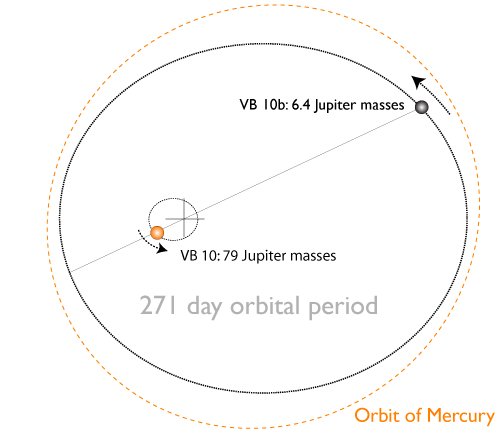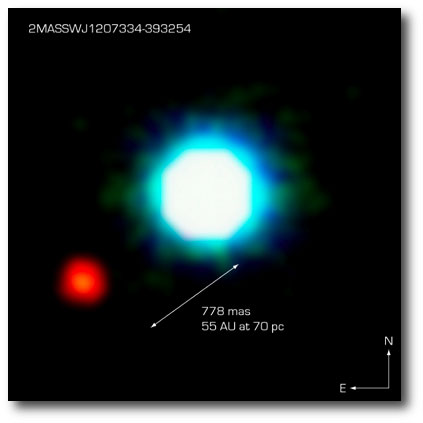
An interesting discovery announcement came across the wire on Friday. In an article to be published in the Astrophysical Journal, Steven Prado and Stuart Shaklan of JPL write up their detection of a ~6 Jupiter mass companion orbiting the nearby ultra-low-mass red dwarf VB 10. Their discovery was made astrometrically, using a modern CCD camera attached to the venerable Palomar 200-inch telescope. JPL put out a press release to go along with the article.
VB 10 contains about 78 Jupiter masses, just barely lifting it above the minimum mass required to qualify as a bona-fide hydrogen-burning main sequence star. It’s got roughly ten times the mass and ten times the density of its companion. In the center-of-mass frame, the system configuration looks like this, where I’m taking a guess at the unknown eccentricity:

I wouldn’t call VB 10b a planet in the usual sense. With a mass of order one-tenth that of its parent star, it’s almost certainly straggling in at the very bottom of the stellar initial mass function. It’s a low-mass brown dwarf impinging into the “planet desert” from above. Gravitational instabilities tend to crop up if a protostellar disk exceeds 10% the mass of its central star, so the VB 10 system probably formed via the fragmentation process that leads to binary stars rather than via the core accretion mechanism that seems to be responsible for the majority of Jovian planets. Presumably, a similar fragmentation-based process had a hand in the formation of 2M1207, in which a ~4 Jupiter-mass secondary orbits a ~25 Jupiter-mass primary:

Photo credit: ESO (VLT/NACO)
At a distance of only 19 light years, VB 10 is (relatively speaking) just right next door. In tandem with its wide binary companion Wolf 1055, it currently ranks as the 68th-nearest known stellar system. That one need not travel far afield to find VB 10b means that objects like VB 10b are probably common in orbit around the most dimunitive red dwarfs.
As instrumentation improves, it’ll eventually become possible to survey the satellite systems of objects like VB 10b. In our solar system, Jupiter, Saturn and Uranus all have roughly 2×10-4 of their primary mass locked up in satellites. I’m guessing that this rule of thumb will continue to hold when exomoons start getting detected, but I bet that it won’t hold true for objects that formed via fragmentation.
The VB 10 system is built to last. The primary will enjoy a main-sequence lifetime of close to ten trillion years, during which time the Milky Way-M31 merger remnant will become increasingly isolated from all the other mass that makes up the currently observable universe. Tidal evolution will gradually tighten up the orbit of VB 10b, meaning that the binary will quite possibly survive and harden further during quadrillions of years of encounters with passing degenerates. Barring other catastrophes, gravitational radiation will eventually bring VB 10 and VB 10b together into merger. That shot of good pure H will revive the dead helium remnant of VB 10, causing it to shine for a further hundred billion years or so.
